Urban Planning in Delhi: Land Acquisition, Housing and Infrastructure
VerifiedAdded on 2023/03/30
|12
|2592
|409
Report
AI Summary
This report provides an overview of the strategic and statutory urban planning models and styles followed in Delhi, India. It identifies the strategies and policies related to land acquisition, zoning regulations, housing policies, and housing delivery systems, distinguishing between formal and informal approaches. The report discusses the implementation of urban plans, highlighting successes and failures in housing and infrastructure development. It examines the coexistence of informal settlements with planned developments, exploring how planning strategies and land policies address informal housing. Furthermore, the report describes attempts to improve the quality and liveability of informal housing through self-help initiatives and regularization efforts. The analysis also delves into the reasons for the persistence of informal housing in developing countries and suggests potential solutions. The document concludes by emphasizing the importance of understanding and addressing the challenges of urban planning in Delhi to foster sustainable and equitable development.

Management
Masters of Urban and Regional Planning
Masters of Urban and Regional Planning
Paraphrase This Document
Need a fresh take? Get an instant paraphrase of this document with our AI Paraphraser
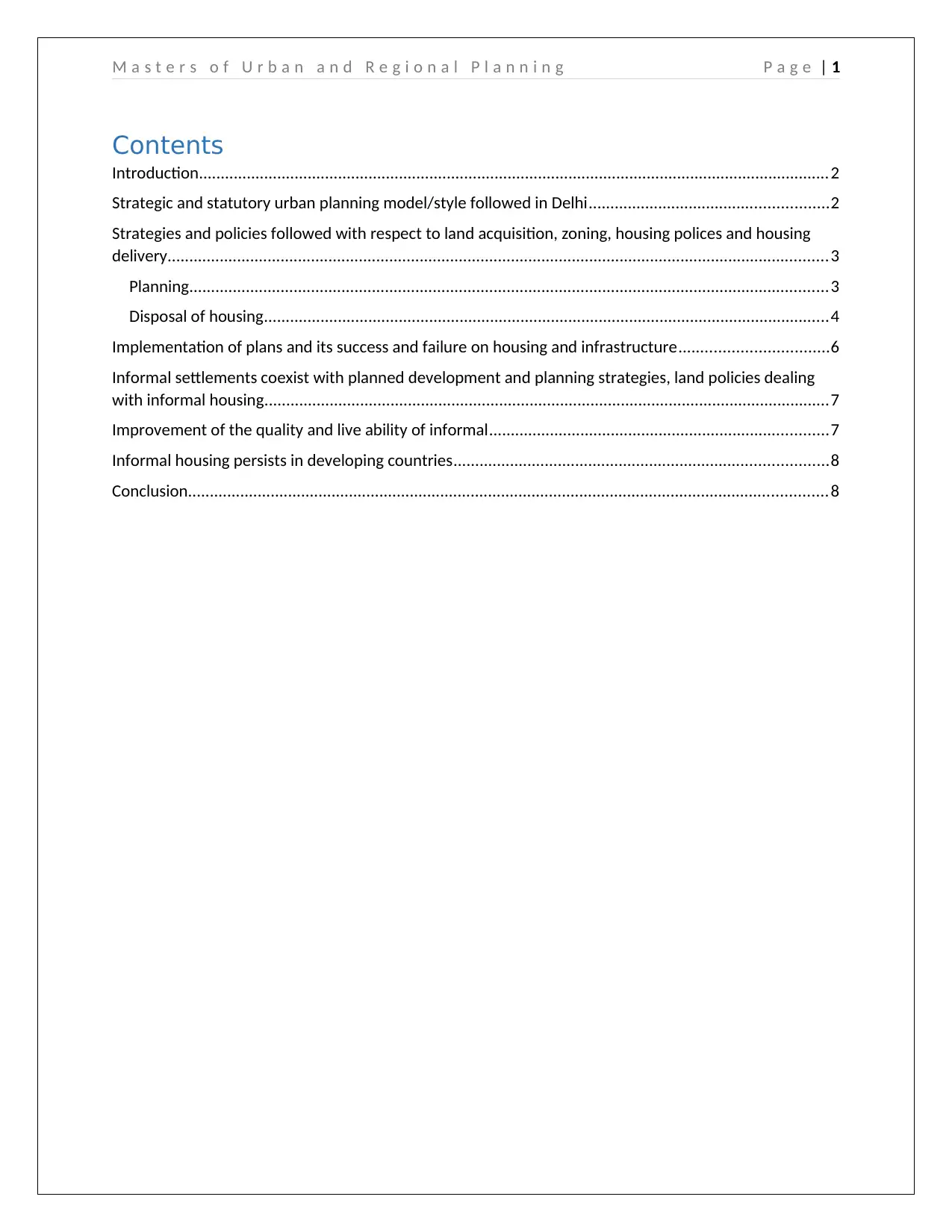
M a s t e r s o f U r b a n a n d R e g i o n a l P l a n n i n g P a g e | 1
Contents
Introduction.................................................................................................................................................2
Strategic and statutory urban planning model/style followed in Delhi.......................................................2
Strategies and policies followed with respect to land acquisition, zoning, housing polices and housing
delivery........................................................................................................................................................3
Planning...................................................................................................................................................3
Disposal of housing..................................................................................................................................4
Implementation of plans and its success and failure on housing and infrastructure..................................6
Informal settlements coexist with planned development and planning strategies, land policies dealing
with informal housing..................................................................................................................................7
Improvement of the quality and live ability of informal..............................................................................7
Informal housing persists in developing countries......................................................................................8
Conclusion...................................................................................................................................................8
Contents
Introduction.................................................................................................................................................2
Strategic and statutory urban planning model/style followed in Delhi.......................................................2
Strategies and policies followed with respect to land acquisition, zoning, housing polices and housing
delivery........................................................................................................................................................3
Planning...................................................................................................................................................3
Disposal of housing..................................................................................................................................4
Implementation of plans and its success and failure on housing and infrastructure..................................6
Informal settlements coexist with planned development and planning strategies, land policies dealing
with informal housing..................................................................................................................................7
Improvement of the quality and live ability of informal..............................................................................7
Informal housing persists in developing countries......................................................................................8
Conclusion...................................................................................................................................................8
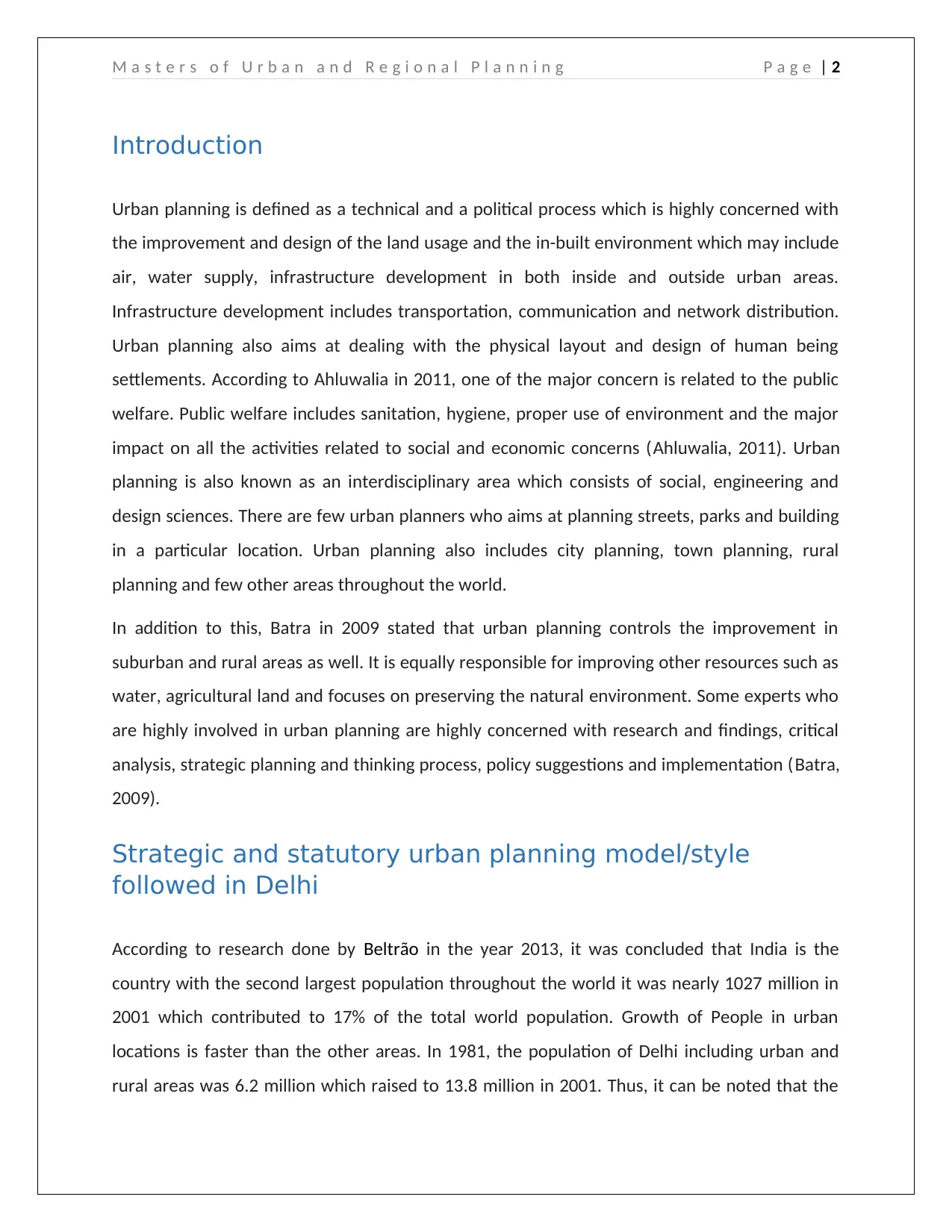
M a s t e r s o f U r b a n a n d R e g i o n a l P l a n n i n g P a g e | 2
Introduction
Urban planning is defined as a technical and a political process which is highly concerned with
the improvement and design of the land usage and the in-built environment which may include
air, water supply, infrastructure development in both inside and outside urban areas.
Infrastructure development includes transportation, communication and network distribution.
Urban planning also aims at dealing with the physical layout and design of human being
settlements. According to Ahluwalia in 2011, one of the major concern is related to the public
welfare. Public welfare includes sanitation, hygiene, proper use of environment and the major
impact on all the activities related to social and economic concerns (Ahluwalia, 2011). Urban
planning is also known as an interdisciplinary area which consists of social, engineering and
design sciences. There are few urban planners who aims at planning streets, parks and building
in a particular location. Urban planning also includes city planning, town planning, rural
planning and few other areas throughout the world.
In addition to this, Batra in 2009 stated that urban planning controls the improvement in
suburban and rural areas as well. It is equally responsible for improving other resources such as
water, agricultural land and focuses on preserving the natural environment. Some experts who
are highly involved in urban planning are highly concerned with research and findings, critical
analysis, strategic planning and thinking process, policy suggestions and implementation (Batra,
2009).
Strategic and statutory urban planning model/style
followed in Delhi
According to research done by Beltrão in the year 2013, it was concluded that India is the
country with the second largest population throughout the world it was nearly 1027 million in
2001 which contributed to 17% of the total world population. Growth of People in urban
locations is faster than the other areas. In 1981, the population of Delhi including urban and
rural areas was 6.2 million which raised to 13.8 million in 2001. Thus, it can be noted that the
Introduction
Urban planning is defined as a technical and a political process which is highly concerned with
the improvement and design of the land usage and the in-built environment which may include
air, water supply, infrastructure development in both inside and outside urban areas.
Infrastructure development includes transportation, communication and network distribution.
Urban planning also aims at dealing with the physical layout and design of human being
settlements. According to Ahluwalia in 2011, one of the major concern is related to the public
welfare. Public welfare includes sanitation, hygiene, proper use of environment and the major
impact on all the activities related to social and economic concerns (Ahluwalia, 2011). Urban
planning is also known as an interdisciplinary area which consists of social, engineering and
design sciences. There are few urban planners who aims at planning streets, parks and building
in a particular location. Urban planning also includes city planning, town planning, rural
planning and few other areas throughout the world.
In addition to this, Batra in 2009 stated that urban planning controls the improvement in
suburban and rural areas as well. It is equally responsible for improving other resources such as
water, agricultural land and focuses on preserving the natural environment. Some experts who
are highly involved in urban planning are highly concerned with research and findings, critical
analysis, strategic planning and thinking process, policy suggestions and implementation (Batra,
2009).
Strategic and statutory urban planning model/style
followed in Delhi
According to research done by Beltrão in the year 2013, it was concluded that India is the
country with the second largest population throughout the world it was nearly 1027 million in
2001 which contributed to 17% of the total world population. Growth of People in urban
locations is faster than the other areas. In 1981, the population of Delhi including urban and
rural areas was 6.2 million which raised to 13.8 million in 2001. Thus, it can be noted that the
⊘ This is a preview!⊘
Do you want full access?
Subscribe today to unlock all pages.

Trusted by 1+ million students worldwide
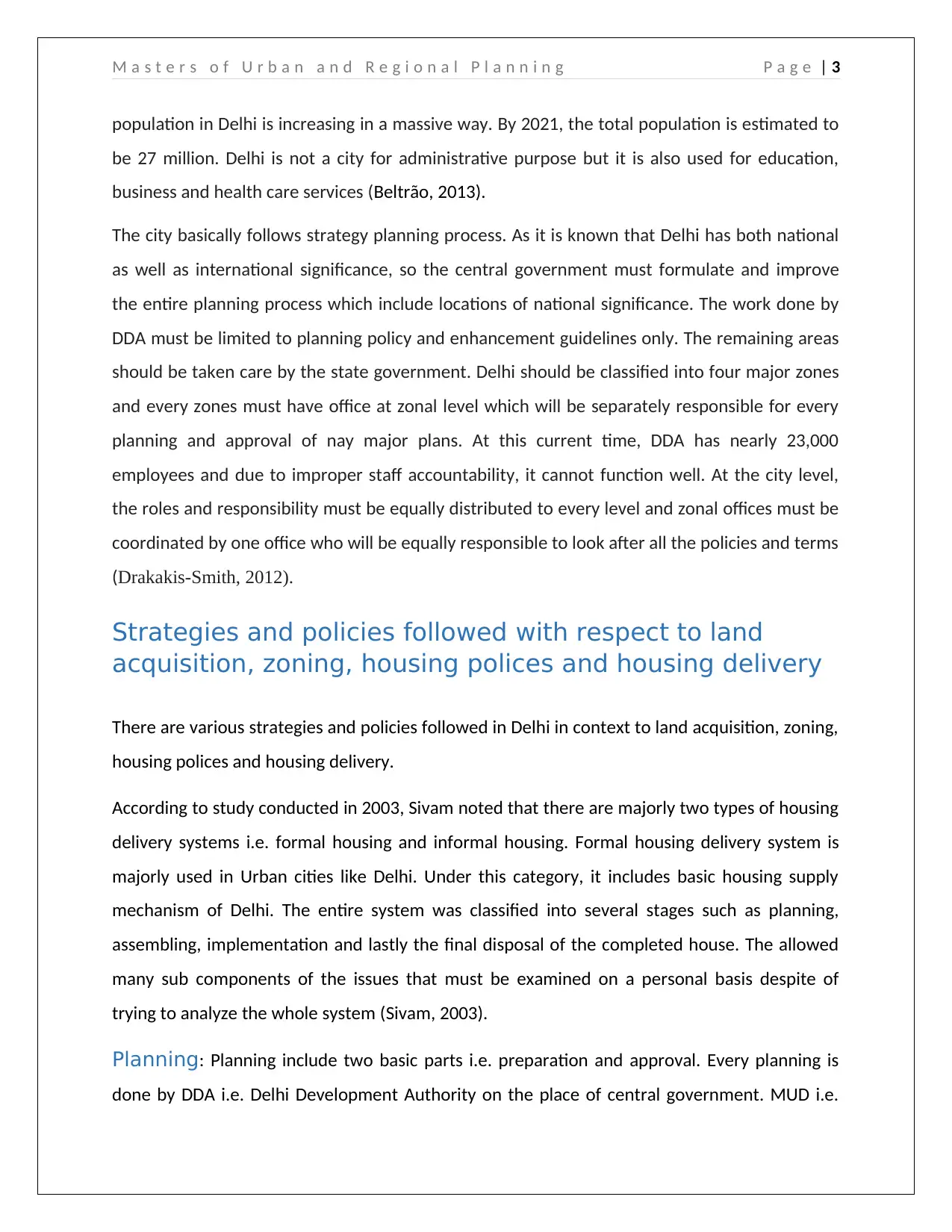
M a s t e r s o f U r b a n a n d R e g i o n a l P l a n n i n g P a g e | 3
population in Delhi is increasing in a massive way. By 2021, the total population is estimated to
be 27 million. Delhi is not a city for administrative purpose but it is also used for education,
business and health care services (Beltrão, 2013).
The city basically follows strategy planning process. As it is known that Delhi has both national
as well as international significance, so the central government must formulate and improve
the entire planning process which include locations of national significance. The work done by
DDA must be limited to planning policy and enhancement guidelines only. The remaining areas
should be taken care by the state government. Delhi should be classified into four major zones
and every zones must have office at zonal level which will be separately responsible for every
planning and approval of nay major plans. At this current time, DDA has nearly 23,000
employees and due to improper staff accountability, it cannot function well. At the city level,
the roles and responsibility must be equally distributed to every level and zonal offices must be
coordinated by one office who will be equally responsible to look after all the policies and terms
(Drakakis-Smith, 2012).
Strategies and policies followed with respect to land
acquisition, zoning, housing polices and housing delivery
There are various strategies and policies followed in Delhi in context to land acquisition, zoning,
housing polices and housing delivery.
According to study conducted in 2003, Sivam noted that there are majorly two types of housing
delivery systems i.e. formal housing and informal housing. Formal housing delivery system is
majorly used in Urban cities like Delhi. Under this category, it includes basic housing supply
mechanism of Delhi. The entire system was classified into several stages such as planning,
assembling, implementation and lastly the final disposal of the completed house. The allowed
many sub components of the issues that must be examined on a personal basis despite of
trying to analyze the whole system (Sivam, 2003).
Planning: Planning include two basic parts i.e. preparation and approval. Every planning is
done by DDA i.e. Delhi Development Authority on the place of central government. MUD i.e.
population in Delhi is increasing in a massive way. By 2021, the total population is estimated to
be 27 million. Delhi is not a city for administrative purpose but it is also used for education,
business and health care services (Beltrão, 2013).
The city basically follows strategy planning process. As it is known that Delhi has both national
as well as international significance, so the central government must formulate and improve
the entire planning process which include locations of national significance. The work done by
DDA must be limited to planning policy and enhancement guidelines only. The remaining areas
should be taken care by the state government. Delhi should be classified into four major zones
and every zones must have office at zonal level which will be separately responsible for every
planning and approval of nay major plans. At this current time, DDA has nearly 23,000
employees and due to improper staff accountability, it cannot function well. At the city level,
the roles and responsibility must be equally distributed to every level and zonal offices must be
coordinated by one office who will be equally responsible to look after all the policies and terms
(Drakakis-Smith, 2012).
Strategies and policies followed with respect to land
acquisition, zoning, housing polices and housing delivery
There are various strategies and policies followed in Delhi in context to land acquisition, zoning,
housing polices and housing delivery.
According to study conducted in 2003, Sivam noted that there are majorly two types of housing
delivery systems i.e. formal housing and informal housing. Formal housing delivery system is
majorly used in Urban cities like Delhi. Under this category, it includes basic housing supply
mechanism of Delhi. The entire system was classified into several stages such as planning,
assembling, implementation and lastly the final disposal of the completed house. The allowed
many sub components of the issues that must be examined on a personal basis despite of
trying to analyze the whole system (Sivam, 2003).
Planning: Planning include two basic parts i.e. preparation and approval. Every planning is
done by DDA i.e. Delhi Development Authority on the place of central government. MUD i.e.
Paraphrase This Document
Need a fresh take? Get an instant paraphrase of this document with our AI Paraphraser
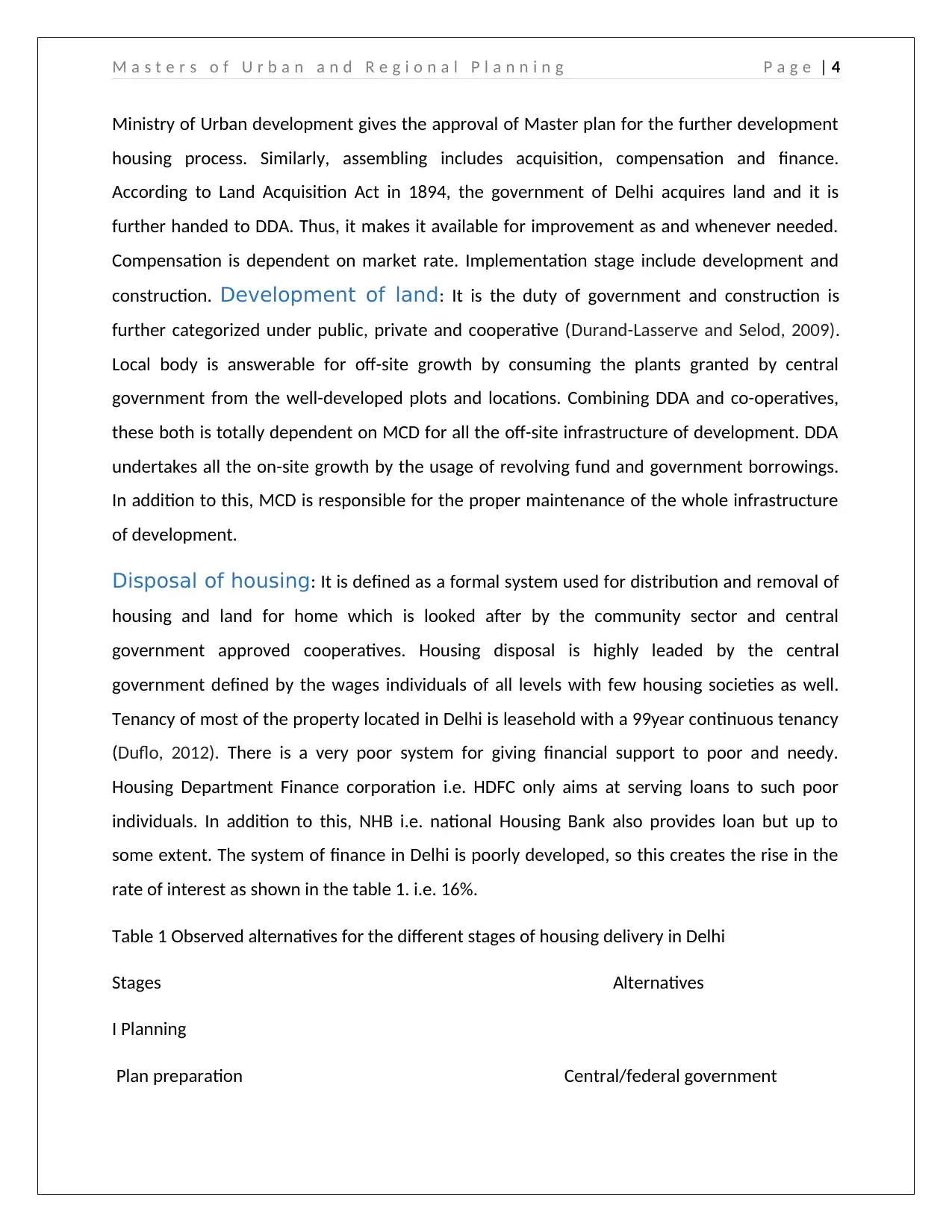
M a s t e r s o f U r b a n a n d R e g i o n a l P l a n n i n g P a g e | 4
Ministry of Urban development gives the approval of Master plan for the further development
housing process. Similarly, assembling includes acquisition, compensation and finance.
According to Land Acquisition Act in 1894, the government of Delhi acquires land and it is
further handed to DDA. Thus, it makes it available for improvement as and whenever needed.
Compensation is dependent on market rate. Implementation stage include development and
construction. Development of land: It is the duty of government and construction is
further categorized under public, private and cooperative (Durand-Lasserve and Selod, 2009).
Local body is answerable for off-site growth by consuming the plants granted by central
government from the well-developed plots and locations. Combining DDA and co-operatives,
these both is totally dependent on MCD for all the off-site infrastructure of development. DDA
undertakes all the on-site growth by the usage of revolving fund and government borrowings.
In addition to this, MCD is responsible for the proper maintenance of the whole infrastructure
of development.
Disposal of housing: It is defined as a formal system used for distribution and removal of
housing and land for home which is looked after by the community sector and central
government approved cooperatives. Housing disposal is highly leaded by the central
government defined by the wages individuals of all levels with few housing societies as well.
Tenancy of most of the property located in Delhi is leasehold with a 99year continuous tenancy
(Duflo, 2012). There is a very poor system for giving financial support to poor and needy.
Housing Department Finance corporation i.e. HDFC only aims at serving loans to such poor
individuals. In addition to this, NHB i.e. national Housing Bank also provides loan but up to
some extent. The system of finance in Delhi is poorly developed, so this creates the rise in the
rate of interest as shown in the table 1. i.e. 16%.
Table 1 Observed alternatives for the different stages of housing delivery in Delhi
Stages Alternatives
I Planning
Plan preparation Central/federal government
Ministry of Urban development gives the approval of Master plan for the further development
housing process. Similarly, assembling includes acquisition, compensation and finance.
According to Land Acquisition Act in 1894, the government of Delhi acquires land and it is
further handed to DDA. Thus, it makes it available for improvement as and whenever needed.
Compensation is dependent on market rate. Implementation stage include development and
construction. Development of land: It is the duty of government and construction is
further categorized under public, private and cooperative (Durand-Lasserve and Selod, 2009).
Local body is answerable for off-site growth by consuming the plants granted by central
government from the well-developed plots and locations. Combining DDA and co-operatives,
these both is totally dependent on MCD for all the off-site infrastructure of development. DDA
undertakes all the on-site growth by the usage of revolving fund and government borrowings.
In addition to this, MCD is responsible for the proper maintenance of the whole infrastructure
of development.
Disposal of housing: It is defined as a formal system used for distribution and removal of
housing and land for home which is looked after by the community sector and central
government approved cooperatives. Housing disposal is highly leaded by the central
government defined by the wages individuals of all levels with few housing societies as well.
Tenancy of most of the property located in Delhi is leasehold with a 99year continuous tenancy
(Duflo, 2012). There is a very poor system for giving financial support to poor and needy.
Housing Department Finance corporation i.e. HDFC only aims at serving loans to such poor
individuals. In addition to this, NHB i.e. national Housing Bank also provides loan but up to
some extent. The system of finance in Delhi is poorly developed, so this creates the rise in the
rate of interest as shown in the table 1. i.e. 16%.
Table 1 Observed alternatives for the different stages of housing delivery in Delhi
Stages Alternatives
I Planning
Plan preparation Central/federal government
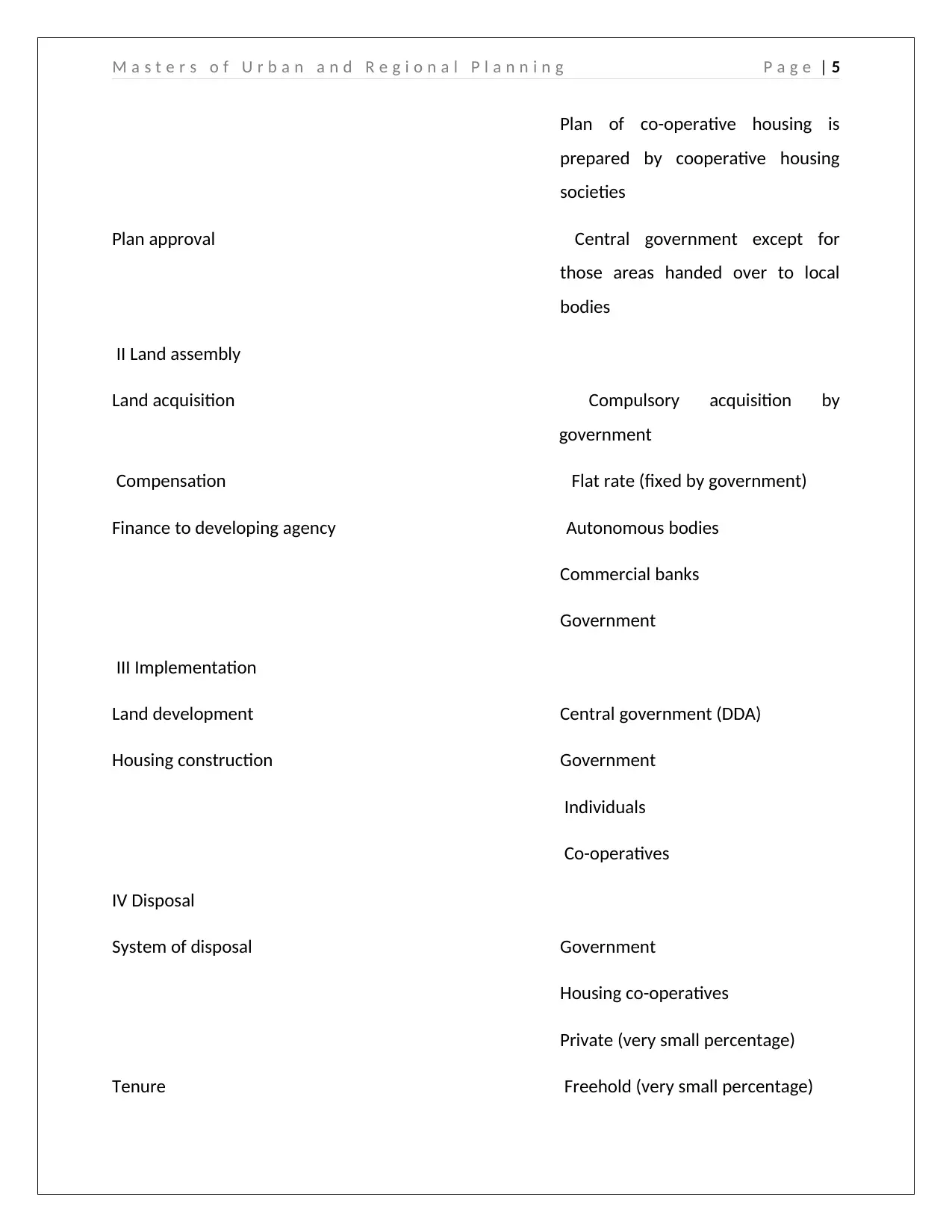
M a s t e r s o f U r b a n a n d R e g i o n a l P l a n n i n g P a g e | 5
Plan of co-operative housing is
prepared by cooperative housing
societies
Plan approval Central government except for
those areas handed over to local
bodies
II Land assembly
Land acquisition Compulsory acquisition by
government
Compensation Flat rate (fixed by government)
Finance to developing agency Autonomous bodies
Commercial banks
Government
III Implementation
Land development Central government (DDA)
Housing construction Government
Individuals
Co-operatives
IV Disposal
System of disposal Government
Housing co-operatives
Private (very small percentage)
Tenure Freehold (very small percentage)
Plan of co-operative housing is
prepared by cooperative housing
societies
Plan approval Central government except for
those areas handed over to local
bodies
II Land assembly
Land acquisition Compulsory acquisition by
government
Compensation Flat rate (fixed by government)
Finance to developing agency Autonomous bodies
Commercial banks
Government
III Implementation
Land development Central government (DDA)
Housing construction Government
Individuals
Co-operatives
IV Disposal
System of disposal Government
Housing co-operatives
Private (very small percentage)
Tenure Freehold (very small percentage)
⊘ This is a preview!⊘
Do you want full access?
Subscribe today to unlock all pages.

Trusted by 1+ million students worldwide

M a s t e r s o f U r b a n a n d R e g i o n a l P l a n n i n g P a g e | 6
Leasehold
Rental
Finance Commercial banks
Financial agencies
Implementation of plans and its success and failure on
housing and infrastructure
There are several plans applied and its accomplishment and failure on housing and
infrastructure
According to a research published by Mishra in 2016, it was found that there is master plan
which is planned for the development in Delhi. As per Delhi Development Authority, “, "A
Master Plan is the long-term perspective plan for guiding the sustainable planned development
of the city. This lays down the planning guidelines, policies, development code and space
requirements for various socio-economic activities supporting the city population during the
plan period. It is also the basis for all infrastructure requirements." (Mishra, 2016).
The Master plan implemented will majorly focus on 18 major areas which is divided from A to
R. based on this plan, the City will turn into a world class city. Such plan is comprised of land
policy, redevelopment, home and housing for the needy, public participation, unauthorized
societies, preservation of cultural heritage, infrastructure development, natural calamities
management and informal sector. The efforts to minimize the population of the capital is also
made by influencing individuals to migrate to suburbs, increasing the limitations of city and
redeveloping the existing areas to hold more number of population. Based on the plan, a huge
number of empty land is lying which is owned by the central government which must be
planned for redevelopment. Those vacant land can be used for other resources. As per the plan,
the people more than 60 years must be comprised of 10.7%. they should be provided homes
and special facilities in public places like buses, ramps, toilets and many more.
Leasehold
Rental
Finance Commercial banks
Financial agencies
Implementation of plans and its success and failure on
housing and infrastructure
There are several plans applied and its accomplishment and failure on housing and
infrastructure
According to a research published by Mishra in 2016, it was found that there is master plan
which is planned for the development in Delhi. As per Delhi Development Authority, “, "A
Master Plan is the long-term perspective plan for guiding the sustainable planned development
of the city. This lays down the planning guidelines, policies, development code and space
requirements for various socio-economic activities supporting the city population during the
plan period. It is also the basis for all infrastructure requirements." (Mishra, 2016).
The Master plan implemented will majorly focus on 18 major areas which is divided from A to
R. based on this plan, the City will turn into a world class city. Such plan is comprised of land
policy, redevelopment, home and housing for the needy, public participation, unauthorized
societies, preservation of cultural heritage, infrastructure development, natural calamities
management and informal sector. The efforts to minimize the population of the capital is also
made by influencing individuals to migrate to suburbs, increasing the limitations of city and
redeveloping the existing areas to hold more number of population. Based on the plan, a huge
number of empty land is lying which is owned by the central government which must be
planned for redevelopment. Those vacant land can be used for other resources. As per the plan,
the people more than 60 years must be comprised of 10.7%. they should be provided homes
and special facilities in public places like buses, ramps, toilets and many more.
Paraphrase This Document
Need a fresh take? Get an instant paraphrase of this document with our AI Paraphraser
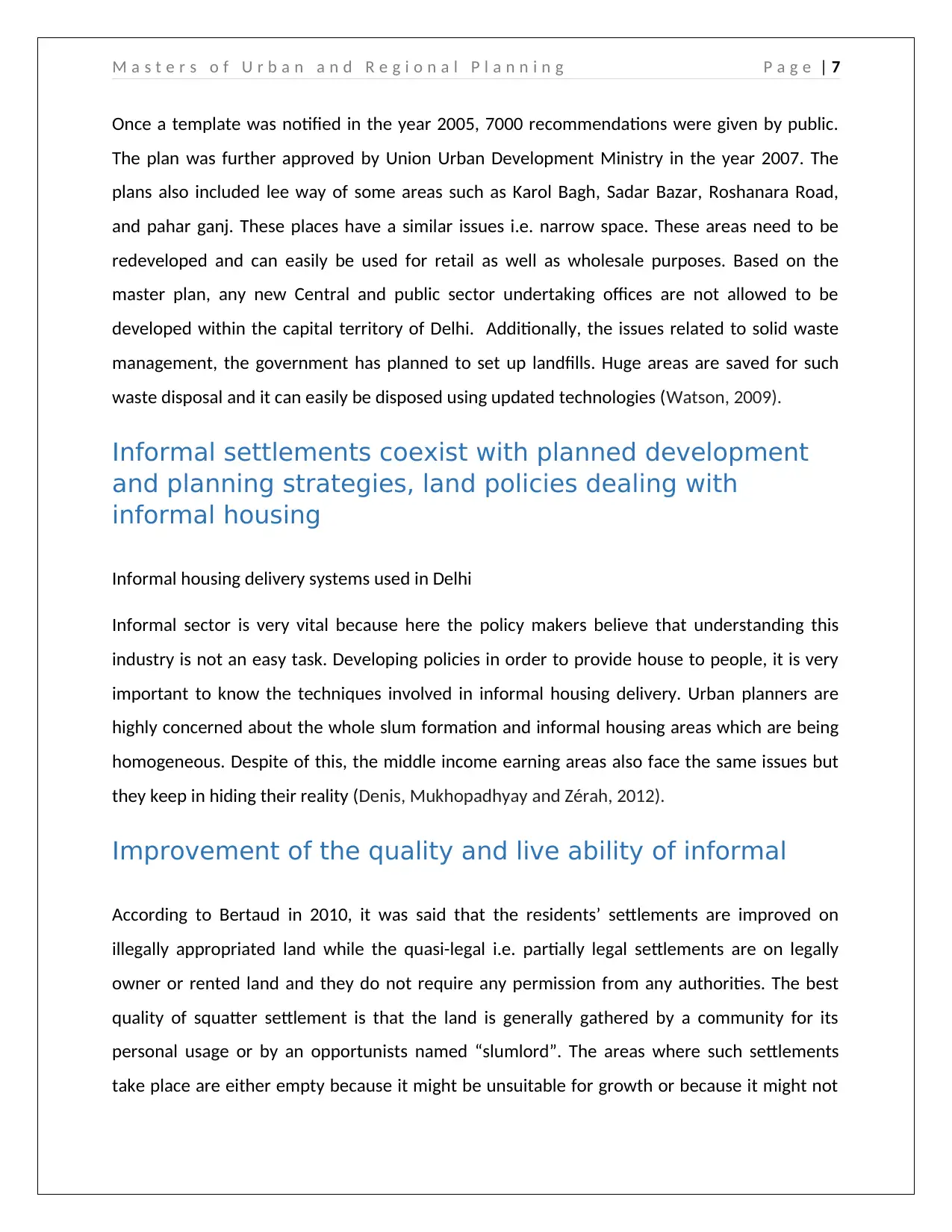
M a s t e r s o f U r b a n a n d R e g i o n a l P l a n n i n g P a g e | 7
Once a template was notified in the year 2005, 7000 recommendations were given by public.
The plan was further approved by Union Urban Development Ministry in the year 2007. The
plans also included lee way of some areas such as Karol Bagh, Sadar Bazar, Roshanara Road,
and pahar ganj. These places have a similar issues i.e. narrow space. These areas need to be
redeveloped and can easily be used for retail as well as wholesale purposes. Based on the
master plan, any new Central and public sector undertaking offices are not allowed to be
developed within the capital territory of Delhi. Additionally, the issues related to solid waste
management, the government has planned to set up landfills. Huge areas are saved for such
waste disposal and it can easily be disposed using updated technologies (Watson, 2009).
Informal settlements coexist with planned development
and planning strategies, land policies dealing with
informal housing
Informal housing delivery systems used in Delhi
Informal sector is very vital because here the policy makers believe that understanding this
industry is not an easy task. Developing policies in order to provide house to people, it is very
important to know the techniques involved in informal housing delivery. Urban planners are
highly concerned about the whole slum formation and informal housing areas which are being
homogeneous. Despite of this, the middle income earning areas also face the same issues but
they keep in hiding their reality (Denis, Mukhopadhyay and Zérah, 2012).
Improvement of the quality and live ability of informal
According to Bertaud in 2010, it was said that the residents’ settlements are improved on
illegally appropriated land while the quasi-legal i.e. partially legal settlements are on legally
owner or rented land and they do not require any permission from any authorities. The best
quality of squatter settlement is that the land is generally gathered by a community for its
personal usage or by an opportunists named “slumlord”. The areas where such settlements
take place are either empty because it might be unsuitable for growth or because it might not
Once a template was notified in the year 2005, 7000 recommendations were given by public.
The plan was further approved by Union Urban Development Ministry in the year 2007. The
plans also included lee way of some areas such as Karol Bagh, Sadar Bazar, Roshanara Road,
and pahar ganj. These places have a similar issues i.e. narrow space. These areas need to be
redeveloped and can easily be used for retail as well as wholesale purposes. Based on the
master plan, any new Central and public sector undertaking offices are not allowed to be
developed within the capital territory of Delhi. Additionally, the issues related to solid waste
management, the government has planned to set up landfills. Huge areas are saved for such
waste disposal and it can easily be disposed using updated technologies (Watson, 2009).
Informal settlements coexist with planned development
and planning strategies, land policies dealing with
informal housing
Informal housing delivery systems used in Delhi
Informal sector is very vital because here the policy makers believe that understanding this
industry is not an easy task. Developing policies in order to provide house to people, it is very
important to know the techniques involved in informal housing delivery. Urban planners are
highly concerned about the whole slum formation and informal housing areas which are being
homogeneous. Despite of this, the middle income earning areas also face the same issues but
they keep in hiding their reality (Denis, Mukhopadhyay and Zérah, 2012).
Improvement of the quality and live ability of informal
According to Bertaud in 2010, it was said that the residents’ settlements are improved on
illegally appropriated land while the quasi-legal i.e. partially legal settlements are on legally
owner or rented land and they do not require any permission from any authorities. The best
quality of squatter settlement is that the land is generally gathered by a community for its
personal usage or by an opportunists named “slumlord”. The areas where such settlements
take place are either empty because it might be unsuitable for growth or because it might not
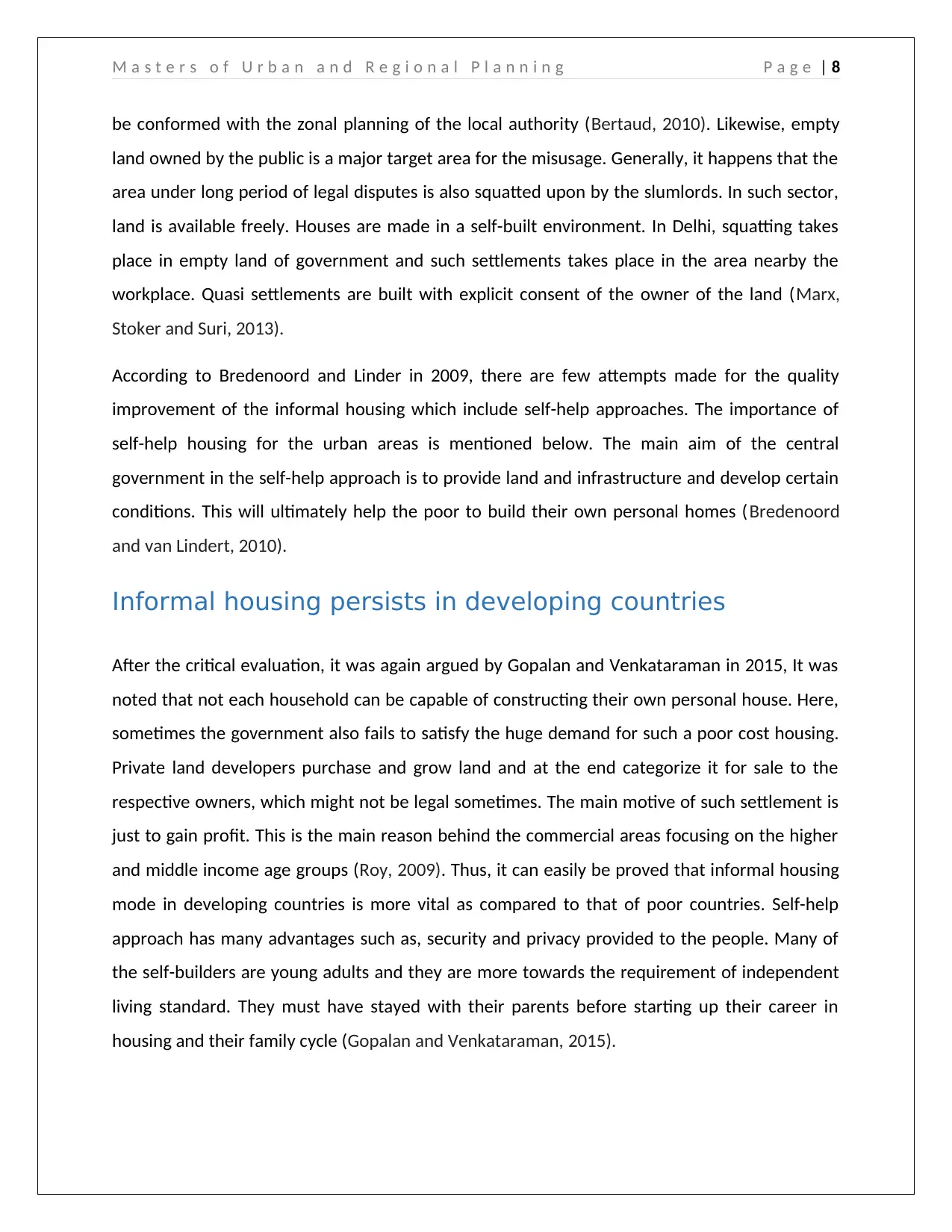
M a s t e r s o f U r b a n a n d R e g i o n a l P l a n n i n g P a g e | 8
be conformed with the zonal planning of the local authority (Bertaud, 2010). Likewise, empty
land owned by the public is a major target area for the misusage. Generally, it happens that the
area under long period of legal disputes is also squatted upon by the slumlords. In such sector,
land is available freely. Houses are made in a self-built environment. In Delhi, squatting takes
place in empty land of government and such settlements takes place in the area nearby the
workplace. Quasi settlements are built with explicit consent of the owner of the land (Marx,
Stoker and Suri, 2013).
According to Bredenoord and Linder in 2009, there are few attempts made for the quality
improvement of the informal housing which include self-help approaches. The importance of
self-help housing for the urban areas is mentioned below. The main aim of the central
government in the self-help approach is to provide land and infrastructure and develop certain
conditions. This will ultimately help the poor to build their own personal homes (Bredenoord
and van Lindert, 2010).
Informal housing persists in developing countries
After the critical evaluation, it was again argued by Gopalan and Venkataraman in 2015, It was
noted that not each household can be capable of constructing their own personal house. Here,
sometimes the government also fails to satisfy the huge demand for such a poor cost housing.
Private land developers purchase and grow land and at the end categorize it for sale to the
respective owners, which might not be legal sometimes. The main motive of such settlement is
just to gain profit. This is the main reason behind the commercial areas focusing on the higher
and middle income age groups (Roy, 2009). Thus, it can easily be proved that informal housing
mode in developing countries is more vital as compared to that of poor countries. Self-help
approach has many advantages such as, security and privacy provided to the people. Many of
the self-builders are young adults and they are more towards the requirement of independent
living standard. They must have stayed with their parents before starting up their career in
housing and their family cycle (Gopalan and Venkataraman, 2015).
be conformed with the zonal planning of the local authority (Bertaud, 2010). Likewise, empty
land owned by the public is a major target area for the misusage. Generally, it happens that the
area under long period of legal disputes is also squatted upon by the slumlords. In such sector,
land is available freely. Houses are made in a self-built environment. In Delhi, squatting takes
place in empty land of government and such settlements takes place in the area nearby the
workplace. Quasi settlements are built with explicit consent of the owner of the land (Marx,
Stoker and Suri, 2013).
According to Bredenoord and Linder in 2009, there are few attempts made for the quality
improvement of the informal housing which include self-help approaches. The importance of
self-help housing for the urban areas is mentioned below. The main aim of the central
government in the self-help approach is to provide land and infrastructure and develop certain
conditions. This will ultimately help the poor to build their own personal homes (Bredenoord
and van Lindert, 2010).
Informal housing persists in developing countries
After the critical evaluation, it was again argued by Gopalan and Venkataraman in 2015, It was
noted that not each household can be capable of constructing their own personal house. Here,
sometimes the government also fails to satisfy the huge demand for such a poor cost housing.
Private land developers purchase and grow land and at the end categorize it for sale to the
respective owners, which might not be legal sometimes. The main motive of such settlement is
just to gain profit. This is the main reason behind the commercial areas focusing on the higher
and middle income age groups (Roy, 2009). Thus, it can easily be proved that informal housing
mode in developing countries is more vital as compared to that of poor countries. Self-help
approach has many advantages such as, security and privacy provided to the people. Many of
the self-builders are young adults and they are more towards the requirement of independent
living standard. They must have stayed with their parents before starting up their career in
housing and their family cycle (Gopalan and Venkataraman, 2015).
⊘ This is a preview!⊘
Do you want full access?
Subscribe today to unlock all pages.

Trusted by 1+ million students worldwide
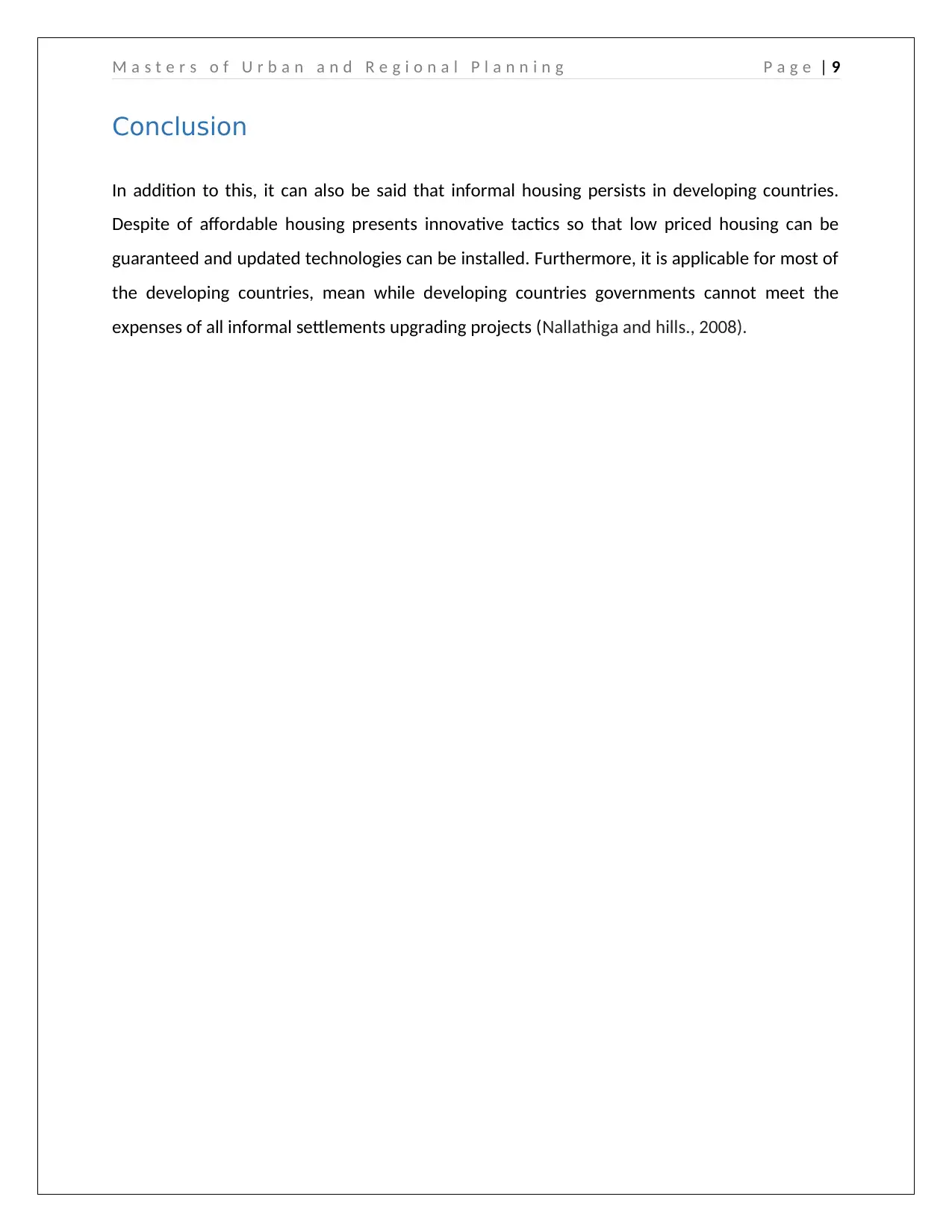
M a s t e r s o f U r b a n a n d R e g i o n a l P l a n n i n g P a g e | 9
Conclusion
In addition to this, it can also be said that informal housing persists in developing countries.
Despite of affordable housing presents innovative tactics so that low priced housing can be
guaranteed and updated technologies can be installed. Furthermore, it is applicable for most of
the developing countries, mean while developing countries governments cannot meet the
expenses of all informal settlements upgrading projects (Nallathiga and hills., 2008).
Conclusion
In addition to this, it can also be said that informal housing persists in developing countries.
Despite of affordable housing presents innovative tactics so that low priced housing can be
guaranteed and updated technologies can be installed. Furthermore, it is applicable for most of
the developing countries, mean while developing countries governments cannot meet the
expenses of all informal settlements upgrading projects (Nallathiga and hills., 2008).
Paraphrase This Document
Need a fresh take? Get an instant paraphrase of this document with our AI Paraphraser

M a s t e r s o f U r b a n a n d R e g i o n a l P l a n n i n g P a g e | 10
References
Ahluwalia, I.J., 2011. Planning for urban development in India.
Batra, L., 2009. A review of urbanization and urban policy in post-independent India. New Delhi:
Centre for the Study of Law and Governance. Working paper series.
Beltrão. G., 2013. India: Promoting Inclusive Urban Development in Indian Cities. Available at:
file:///C:/Users/Asus/Downloads/Documents/41609-012-tacr-01.pdf (Online)
Bertaud, A., 2010. Land markets, government interventions, and housing affordability.
Wolfensohn Center for Development at Brookings.
Bredenoord, J. and van Lindert, P., 2010. Pro-poor housing policies: rethinking the potential of
assisted self-help housing. Habitat International, 34(3), pp.278-287.
Denis, E., Mukhopadhyay, P. and Zérah, M.H., 2012. Subaltern urbanization in India. Economic
and political weekly, 47(30), pp.52-62.
Drakakis-Smith, D., 2012. Urbanization, housing and the development process. Routledge.
Duflo, E., 2012. Women empowerment and economic development. Journal of Economic
literature, 50(4), pp.1051-79.
Durand-Lasserve, A. and Selod, H., 2009. The formalization of urban land tenure in developing
countries. In Urban Land Markets (pp. 101-132). Springer, Dordrecht.
Gopalan, K. and Venkataraman, M., 2015. Affordable housing: Policy and practice in India. IIMB
Management Review, 27(2), pp.129-140.
Marx, B., Stoker, T. and Suri, T., 2013. The economics of slums in the developing world. Journal
of Economic Perspectives, 27(4), pp.187-210.
Mishra, S., 2016. 9 Things You Should Know About Delhi Master Plan 2021. Available at:
https://www.proptiger.com/guide/post/9-things-you-should-know-about-delhi-master-plan-
2021 (Online)
References
Ahluwalia, I.J., 2011. Planning for urban development in India.
Batra, L., 2009. A review of urbanization and urban policy in post-independent India. New Delhi:
Centre for the Study of Law and Governance. Working paper series.
Beltrão. G., 2013. India: Promoting Inclusive Urban Development in Indian Cities. Available at:
file:///C:/Users/Asus/Downloads/Documents/41609-012-tacr-01.pdf (Online)
Bertaud, A., 2010. Land markets, government interventions, and housing affordability.
Wolfensohn Center for Development at Brookings.
Bredenoord, J. and van Lindert, P., 2010. Pro-poor housing policies: rethinking the potential of
assisted self-help housing. Habitat International, 34(3), pp.278-287.
Denis, E., Mukhopadhyay, P. and Zérah, M.H., 2012. Subaltern urbanization in India. Economic
and political weekly, 47(30), pp.52-62.
Drakakis-Smith, D., 2012. Urbanization, housing and the development process. Routledge.
Duflo, E., 2012. Women empowerment and economic development. Journal of Economic
literature, 50(4), pp.1051-79.
Durand-Lasserve, A. and Selod, H., 2009. The formalization of urban land tenure in developing
countries. In Urban Land Markets (pp. 101-132). Springer, Dordrecht.
Gopalan, K. and Venkataraman, M., 2015. Affordable housing: Policy and practice in India. IIMB
Management Review, 27(2), pp.129-140.
Marx, B., Stoker, T. and Suri, T., 2013. The economics of slums in the developing world. Journal
of Economic Perspectives, 27(4), pp.187-210.
Mishra, S., 2016. 9 Things You Should Know About Delhi Master Plan 2021. Available at:
https://www.proptiger.com/guide/post/9-things-you-should-know-about-delhi-master-plan-
2021 (Online)

M a s t e r s o f U r b a n a n d R e g i o n a l P l a n n i n g P a g e | 11
Nallathiga, R. and Hills, J., 2008. Metropolitan Urban Governance Approaches and Models:
Some Implications for Indian Cities.
Roy, A., 2009. Why India cannot plan its cities: Informality, insurgence and the idiom of
urbanization. Planning theory, 8(1), pp.76-87.
Sivam, A., 2003. Housing supply in Delhi. Institute of Social Research, Vol. 20, No. 2, p. 135–141.
Available at: file:///C:/Users/Asus/Downloads/Documents/Sivam.pdf (Online)
Watson, V., 2009. ‘The planned city sweeps the poor away…’: Urban planning and 21st century
urbanization. Progress in planning, 72(3), pp.151-193.
Nallathiga, R. and Hills, J., 2008. Metropolitan Urban Governance Approaches and Models:
Some Implications for Indian Cities.
Roy, A., 2009. Why India cannot plan its cities: Informality, insurgence and the idiom of
urbanization. Planning theory, 8(1), pp.76-87.
Sivam, A., 2003. Housing supply in Delhi. Institute of Social Research, Vol. 20, No. 2, p. 135–141.
Available at: file:///C:/Users/Asus/Downloads/Documents/Sivam.pdf (Online)
Watson, V., 2009. ‘The planned city sweeps the poor away…’: Urban planning and 21st century
urbanization. Progress in planning, 72(3), pp.151-193.
⊘ This is a preview!⊘
Do you want full access?
Subscribe today to unlock all pages.

Trusted by 1+ million students worldwide
1 out of 12
Related Documents
Your All-in-One AI-Powered Toolkit for Academic Success.
+13062052269
info@desklib.com
Available 24*7 on WhatsApp / Email
![[object Object]](/_next/static/media/star-bottom.7253800d.svg)
Unlock your academic potential
Copyright © 2020–2025 A2Z Services. All Rights Reserved. Developed and managed by ZUCOL.





